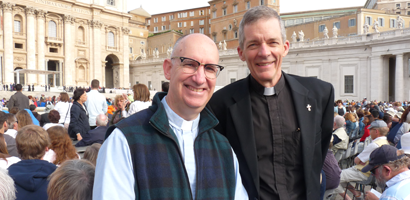
Editor's note: Deacon John Kopfle and his wife Nancy of St. Vincent de Paul Parish in Charlotte and Deacon Jim Bozik of St. Peter Parish in Charlotte are in Rome this week to attend the Deacons' Jubilee and tour the city.
This is part of the Extraordinary Jubilee Year of Mercy proclaimed by Pope Francis, lasting from the Solemnity of the Immaculate Conception on Dec. 8, 2015, until the Solemnity of Christ the King on Nov. 20, 2016.
Monday, May 23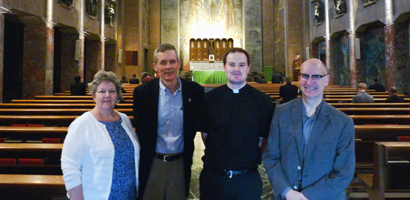 Greetings from the Eternal City. We had a (thankfully) uneventful trip from Charlotte and arrived Monday morning. It is a blessing to have a direct flight to Rome this time of year. The weather promises to be delightful – mid to high 70s and sunny. We are staying at the Cardinal Cesi Hotel, just a few hundred meters from St. Peter's.
Greetings from the Eternal City. We had a (thankfully) uneventful trip from Charlotte and arrived Monday morning. It is a blessing to have a direct flight to Rome this time of year. The weather promises to be delightful – mid to high 70s and sunny. We are staying at the Cardinal Cesi Hotel, just a few hundred meters from St. Peter's.
We are excited to be here to celebrate the Jubilee for Deacons with 1,000 deacons or more from around the world and their families and friends. In addition to the celebration for deacons, there are a number of other jubilees this year: for pilgrims, for the Roman Curia, for those devoted to the spirituality of Divine Mercy, for boys and girls, for priests, for the sick and persons with disabilities, for youth, for workers and volunteers of mercy, for catechists, to honor our Blessed Mother, and for prisoners.
In his proclamation of the Extraordinary Jubilee, the Holy Father said, "The Extraordinary Jubilee has at its center the mercy of God. It will be a Holy Year of Mercy. We want to live in the light of the word of the Lord: "Be merciful, even as your Father is merciful" (cf. Lk 6:36)."
It is truly an honor to be part of the celebration this week and do our part to spread mercy to those we meet.
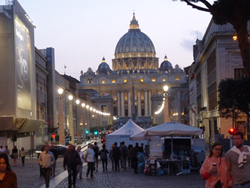
The Deacons' Jubilee will be Friday through Sunday and includes talks on mercy at the Jubilee churches on Friday, passage through the Holy Door of St. Peter's Basilica on Saturday (with the possibility of a plenary indulgence), and Mass with the Holy Father on Sunday. (The Mass will be broadcast by EWTN on Sunday, May 31, live at 4:30 a.m. ET and again at 2:30 p.m. ET.)
In addition, we plan to tour several churches and visit a number of the tourist sites.
Today we oriented ourselves to the area and toured the Castel Sant'Angelo, which was originally the tomb of the Roman Emperor Hadrian around the year 130, but later was the residence of several popes.
This evening Deacon David McCanless, a seminarian from the Charlotte Diocese, gave us a tour of the Pontifical North American College and we participated in Vespers with all the seminarians. (Pictured near the top.)
It was a moving experience praying with seminarians from throughout the U.S. Afterwards, we shared dinner with Deacon McCanless and solved a number of the world's problems, but not all. Deacon McCanless will be ordained a priest June 18 at St. Mark in Huntersville.
The North American College is a seminary and is under the special patronage of the Apostolic See and the care of the Holy Father. It is under the immediate supervision of the U.S. Conference of Catholic Bishops and hosts Americans and Australians. The Diocese of Charlotte usually has a number of men studying here for the priesthood and for advanced degrees.
We ask for your prayers this week as we continue our journey.
EXTRA: Read Deacon Jim Bozik's daily reflection for Monday: https://penzu.com/public/4752638b
Tuesday, May 24
A busy day. We decided to tour St. Peter's this morning to avoid the large crowds. Although there were many people in the square, we passed through security quickly and signed up for the tour of the main dome. Following an elevator ride, we walked along the roof of the basilica, then climbed 323 steps through very narrow passageways to the very top. A strenuous climb, but well worth it. From the top, one gets a wonderful view of Rome and the grounds of Vatican City, the world's smallest state, comprised of only 110 acres and just over 800 people. We saw Pope Francis' residence, the Vatican broadcasting building, the gardens, Pope Benedict's residence, and the Vatican Museums.
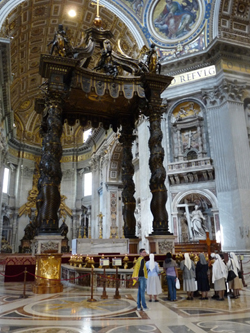
After an easy climb down, we toured St. Peter's Basilica, the largest Catholic church in the world. Lengthwise it measures nearly 200 meters and the lengths of many large churches are shown on the floor, including the National Shrine in Washington and St. Patrick's Cathedral in New York. St. Peter's is truly an amazing place with so much going on: tours for the thousands of pilgrims, Masses in the many side chapels, processions for the Jubilee of Mercy up the aisle to the main altar, even a wedding. Observing the many nationalities represented, one can see we are a universal Church.
Some observations:
· The Pieta, located just inside the main doors to the right, is one of the most famous sculptures in the world. It depicts the Blessed Mother holding Jesus' body after He was taken down from the cross. It was created by Michelangelo in his 20s from a single block of Carrera marble. Unfortunately it was damaged in 1972 by a deranged man, but it has been completely restored and it now sits behind bulletproof glass.
· There is a statue of St. Peter sitting in a chair to the right of the main altar. The tradition is to touch or kiss his left foot for a blessing. So many people have done this that the foot is quite worn down.
· The main altar is used only for Masses celebrated by the pope. Our guide noted that it is the center of Christianity because St. Peter is buried directly beneath it.
Afterwards, we toured the Vatican Museums, one of the largest museums in the world. The tour guide said that the crowds have been very large this year for the Jubilee, around 30,000 people per day. At times we could barely move along the tour route. During the tour, our guide spotted Pope Emeritus Benedict XVI strolling along a walkway.
In the afternoon, we picked up our biglietto (tickets) for the audience with Pope Francis on Wednesday. The U.S. Conference of Catholic Bishops has an office in Rome that assists pilgrims in securing tickets. Afterwards, we walked to the Trevi Fountain and Spanish Steps, two of the more popular sites in Rome.
Add in some shopping for religious items and it was quite a day. No one had a Fitbit on, but undoubtedly we walked at least 20,000 steps.
EXTRA: Read Deacon Jim Bozik's daily reflection for Tuesday: https://penzu.com/public/df06e01d
Wednesday, May 25
An early start today – breakfast at 7:30, then we queued up for the general audience with Pope Francis. The crowds were very large going through security, but we were in St. Peter's Square by 8:45. The security is tight around Rome, with Italian soldiers armed with machine guns. Unfortunately, a sign of our times.
After entering the square we took seats near the front of the general section and waited. There was a great sense of anticipation, with pilgrims from around the world excited to be in the presence of the Holy Father. It's a great experience to be in the midst of such a crowd that realizes someone important is about to appear. But unlike a movie star or sports hero, this person represents something so much more important – the salvation of souls!
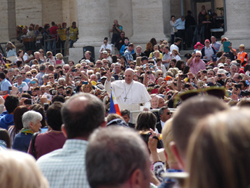 First, speakers announced groups of pilgrims from various countries, with the nationalities cheering all the while. At 9:30, we saw the crowd to the left of St. Peter's rise in anticipation and then on the TV screen the popemobile appeared. A few seconds later, Pope Francis appeared in the flesh. The vehicle made a few passes around the square, with the Holy Father waving and once or twice disembarking to greet and kiss babies and the disabled. Then, the popemobile made its way to the stage and the pope walked up the stairs, with special guests to either side.
First, speakers announced groups of pilgrims from various countries, with the nationalities cheering all the while. At 9:30, we saw the crowd to the left of St. Peter's rise in anticipation and then on the TV screen the popemobile appeared. A few seconds later, Pope Francis appeared in the flesh. The vehicle made a few passes around the square, with the Holy Father waving and once or twice disembarking to greet and kiss babies and the disabled. Then, the popemobile made its way to the stage and the pope walked up the stairs, with special guests to either side.
For the program, the Gospel was read in Italian, Spanish, Portugese, German, English, French, Polish and Arabic. Then the Holy Father read his homily in Italian followed by summaries in each language, again demonstrating the universality of the Church. The Gospel was the parable about the persistent widow. The homily hit home for me because the message was that we must persevere (in prayer) like the widow and we must trust God. We have several people in our family who are experiencing difficulties, and I know I must keep praying for them and trust that God will take care of them.
Finally, the Our Father was sung in Latin and Pope Francis imparted his apostolic blessing, which he said applied to families, friends, the young and people experiencing difficulties.
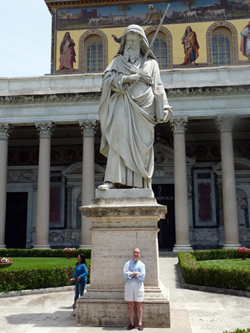 Deacon Jim Bozik at St. Paul's Outside the Walls
Deacon Jim Bozik at St. Paul's Outside the Walls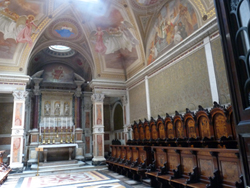 St. Lawrence Chapel
St. Lawrence Chapel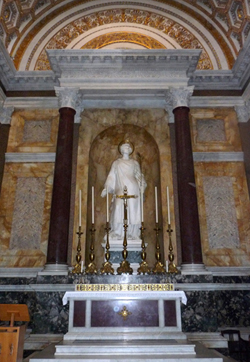 St. Stephen ChapelWe then traveled to visit the Basilica of St. Paul Outside the Walls. It is one of the four major basilicas in Rome, the others being St. John Lateran, St. Peter's and St. Mary Major. St. Paul's is very large outside, but it is not so special in appearance. However, once we stepped inside, we were struck by its detailed artwork and architectural features. More Corinthian columns than we have ever seen! The basilica was founded in the 300s by the Roman Emperor Constantine I over the burial place of St. Paul. There was also a Benedictine monastery on the grounds. In 1823, a major fire nearly destroyed the church and it was rebuilt. As part of the restoration, a portico with gardens was added, in Greek style.
St. Stephen ChapelWe then traveled to visit the Basilica of St. Paul Outside the Walls. It is one of the four major basilicas in Rome, the others being St. John Lateran, St. Peter's and St. Mary Major. St. Paul's is very large outside, but it is not so special in appearance. However, once we stepped inside, we were struck by its detailed artwork and architectural features. More Corinthian columns than we have ever seen! The basilica was founded in the 300s by the Roman Emperor Constantine I over the burial place of St. Paul. There was also a Benedictine monastery on the grounds. In 1823, a major fire nearly destroyed the church and it was rebuilt. As part of the restoration, a portico with gardens was added, in Greek style.
Four special features of the basilica: 1) paintings of all the popes line the walls and interestingly, the current pope's image is lit; 2) there is a holy door that is opened only during jubilees; 3) the sarcophagus of St. Paul is beneath the main (papal) altar (it was a moving experience to pray before it); and 4) two of the side chapels are named for the deacons Stephen and Lawrence, which we appreciated.
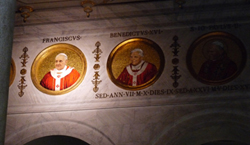 The weather has been very good, with lows around 60 degrees and highs around 75.
The weather has been very good, with lows around 60 degrees and highs around 75.
There is one light note I forgot to mention yesterday about the tour of the Vatican Museums. Among the hundreds of faces we saw in the various frescoes, mosaics, paintings and tapestries, our guide mentioned two that relate to modern times. About the first, she said, "Would you like to see Bill Clinton? Well, look to the right in that painting." Sure enough, the man bears an uncanny resemblance to our 42nd president. Then, toward the end of the tour, she asked us, "Would you like to see Sylvester Stallone?" and Rocky appeared in the painting above us. Good to hear some levity in the hallowed halls of the museum.
With such moving spiritual experiences, wonderful sights, great fellowship and good pasta, wine and weather, we are truly blessed this week.
EXTRA: Read Deacon Jim Bozik's daily reflection for Wednesday: https://penzu.com/public/e093c00d
Thursday, May 26
Our first disappointment of the trip today, but more on that later. In the morning, we toured the Colosseum and Forum. The Colosseum is an oval amphitheater in Rome, completed in the year 80 by the Emperor Titus. It is the largest amphitheater ever built and it hosted contests between men and animals, who often fought to the death. The purpose of the contests was for the emperors to demonstrate their power and amuse the spectators. The structure seated about 70,000 people, about the same size as today's sports arenas. It was used for contests until the 500s and large parts of it remain standing today.
Next we toured the Forum, the political, religious and social center of Roman life from the 7th century B.C. until the 6th century A.D. It occupies a vast area adjacent to the Colosseum and contained numerous temples devoted to the Roman gods, government buildings and residences.
Until the Emperor Constantine, the Roman Empire was largely pagan and Christians were persecuted. The Edict of Milan in 313 stated that Christians should be allowed to follow their beliefs without oppression and also protected people of all faiths from religious persecution. The Christian Church wisely began to adopt pagan buildings and practices for Christian use. The Roman temples were often retained, but modified and transformed into churches. A great example is a temple built by the Roman Emperor Antoninus Pius in honor of his wife Faustina. Constructed in 141 A.D., it is now a church. Gee, that name Faustina sounds familiar... Some of the events held during the Roman Saturnalia feast in late December became part of the Christmas celebration. After Christianity was allowed in the empire, a chapel was built in the Colosseum and even today, the Holy Father celebrates the Stations of the Cross on Good Friday there.
After lunch, we walked to St. John Lateran, one of the four major basilicas in Rome and also its cathedral (good trivia question, because most people will say St. Peter's is the cathedral). We eagerly anticipated a tour, but alas, it was closed because of a papal Mass for Corpus Christi to be held there this evening, followed by a Eucharistic Procession to St. Mary Major, the fourth major basilica in Rome. We walked around the building, gaining an appreciation of its size and beauty.
Tomorrow the first event of the Deacons' Jubilee will be held, a talk on "The Deacon: Image of Mercy for the Promotion of the New Evangelization." We look forward to meeting our brother deacons and their wives from around the world.
EXTRA: Read Deacon Jim Bozik's daily reflection for Thursday: https://penzu.com/public/0c3a0c23
Friday, May 27
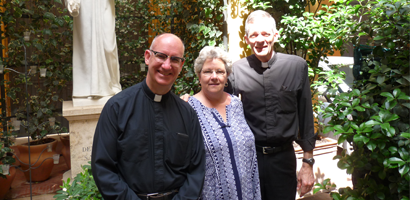 We began with Mass at 8:30 in St. Peter's. There are a number of Masses in the morning in various languages in the many chapels around the periphery of the basilica. The Mass was celebrated in the Blessed Sacrament Chapel, which has a large, heavy curtain to keep the noise down from the main part of the basilica. During the day, it is an adoration chapel with no photos or talking allowed. The celebrant was an elderly Italian priest with a strong voice. He processed in, carrying the chalice, which was interesting. He celebrated the Mass in Italian and ad orientem and set a very reverent tone throughout, respecting the sacredness of the ceremony. Communion was by intinction. At the end, he exposed the Blessed Sacrament for adoration throughout the day.
We began with Mass at 8:30 in St. Peter's. There are a number of Masses in the morning in various languages in the many chapels around the periphery of the basilica. The Mass was celebrated in the Blessed Sacrament Chapel, which has a large, heavy curtain to keep the noise down from the main part of the basilica. During the day, it is an adoration chapel with no photos or talking allowed. The celebrant was an elderly Italian priest with a strong voice. He processed in, carrying the chalice, which was interesting. He celebrated the Mass in Italian and ad orientem and set a very reverent tone throughout, respecting the sacredness of the ceremony. Communion was by intinction. At the end, he exposed the Blessed Sacrament for adoration throughout the day.
As I reflected after Mass, I thought how important it is for us believers to witness sacred spaces like St. Peter's nave and the many chapels. The magnificent architecture, tabernacles, altars, statues, frescoes, paintings, mosaics, etc., allow us to leave the world for a time and ponder God's greatness and love. In these beautiful and sacred places, we can enter the realm of heaven, where there is no more sin, suffering, cruelty, poverty or violence – only light, happiness and peace.
We then did some more shopping. Rome has an amazing variety of stores and street vendors where one can buy religious articles. They range from the magnificent and pricey to the tacky and cheap – something for every pocketbook and taste. Although it seems a bit much at times, it is good to see people buying things not for pleasure alone, but because they hope it will help them and their loved ones and friends grow closer to God and attain everlasting life.
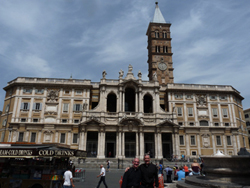 The deacons in front of St. Mary MajorFour more churches today! First was the Basilica of St. Mary Major, our fourth and final major basilica. It was built in the early 400s and is the largest Catholic Marian church in Rome. The Crypt of the Nativity beneath the main altar is said to contain wood from Jesus' crib. Next we walked to the Gesu (Jesus) Church, the mother church of the Society of Jesus (Jesuit order). Unfortunately, the church was closed for lunch, as is the custom for many churches and shops in Rome. Deacon Jim, assigned to the Jesuit St. Peter's Parish in Charlotte, was quite disappointed, but maybe we can see the inside on Sunday. We then tried to walk to the Basilica of Santa Maria Sopra Minerva to hear the talk for deacons, but we ended up at Sant'Andrea della Valle, our third church of the day, yet another basilica. It was worth the wrong turn. Behind the main altar is a striking painting depicting the crucifixion of St. Andrew on a diagonal cross.
The deacons in front of St. Mary MajorFour more churches today! First was the Basilica of St. Mary Major, our fourth and final major basilica. It was built in the early 400s and is the largest Catholic Marian church in Rome. The Crypt of the Nativity beneath the main altar is said to contain wood from Jesus' crib. Next we walked to the Gesu (Jesus) Church, the mother church of the Society of Jesus (Jesuit order). Unfortunately, the church was closed for lunch, as is the custom for many churches and shops in Rome. Deacon Jim, assigned to the Jesuit St. Peter's Parish in Charlotte, was quite disappointed, but maybe we can see the inside on Sunday. We then tried to walk to the Basilica of Santa Maria Sopra Minerva to hear the talk for deacons, but we ended up at Sant'Andrea della Valle, our third church of the day, yet another basilica. It was worth the wrong turn. Behind the main altar is a striking painting depicting the crucifixion of St. Andrew on a diagonal cross.
The final church was St. Maria Sopra Minerva – like many Rome churches nondescript on the outside, but magnificent within. It contains the relics of St. Catherine of Siena. A conclave was held there in the 1400s to elect a pope. There were three talks given in the church by well-known deacons on the topic: "The Deacon: Image of Mercy for the Promotion of the New Evangelization."
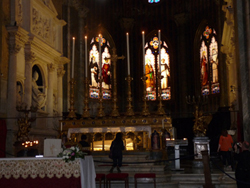 St Catherine at Santa Maria Basilica
St Catherine at Santa Maria Basilica
Themes that resonated with us were: 1) deacons are the face of mercy to the community, 2) we are called to "pour the Gospel into the wounds of others," 3) we should go where the Church has not gone, or go in ways she has not gone, 4) we are on the frontlines and are called to witness to God's presence in the world. Wow, that's a lot to ponder!
Each night the three of us gather for dinner, good conversation and reflections on the day. The many sidewalk cafes are perfect venues with the beautiful weather. We thank God for a very good week thus far.
EXTRA: Read Deacon Jim Bozik's daily reflection for Friday: https://penzu.com/public/c8a1a444
Saturday, May 28
What a day! More on that in a bit, but first a postscript from Friday. In the photo (above) of Deacon Jim, Nancy and Deacon John in the courtyard of the Cardinal Cesi Hotel, John’s face is bathed in sunlight. This just shows that God’s light shines on sinners and saints alike.
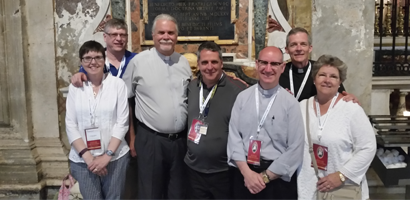 We have been joined by other pilgrims from the Diocese of Charlotte: Deacon Michael Martini and his wife Christina from St. Paul the Apostle Parish in Greensboro, Deacon Chip Wilson from Queen of the Apostles Parish in Belmont, and Deacon Mark Nash, who splits his time between Immaculate Conception Parish in Hendersonville and Daytona Beach, Fla.
We have been joined by other pilgrims from the Diocese of Charlotte: Deacon Michael Martini and his wife Christina from St. Paul the Apostle Parish in Greensboro, Deacon Chip Wilson from Queen of the Apostles Parish in Belmont, and Deacon Mark Nash, who splits his time between Immaculate Conception Parish in Hendersonville and Daytona Beach, Fla.
A nice touch at the Cardinal Cesi Hotel is the daily Gospel reading slipped under the door. One doesn't see that at many hotels!
We got a later start today because of the procession to the Holy Door of St. Peter's (pictured above). Four groups of deacons and wives (thousands of people in all), divided by language spoken, began near Sant'Angelo Castel. The procession stopped four times for prayer.
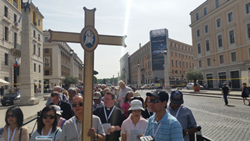
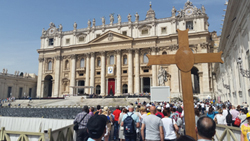 The initial reflection expressed beautifully the purpose of the procession: "You are about to traverse the short distance that still separates you from the Holy Door. Collect your thoughts and the intentions you want to take with you to the goal of your pilgrimage. Look at the people with whom you are proceeding toward the Basilica, and think of those whom you would like to have with you in this moment, but who for various reasons are not here; perhaps because they are sick or too old, or they are not participating because they have lost their faith. Remember all your deceased loved ones. Gather all these people and situations in your heart, and carry them with you to the Door of Mercy."
The initial reflection expressed beautifully the purpose of the procession: "You are about to traverse the short distance that still separates you from the Holy Door. Collect your thoughts and the intentions you want to take with you to the goal of your pilgrimage. Look at the people with whom you are proceeding toward the Basilica, and think of those whom you would like to have with you in this moment, but who for various reasons are not here; perhaps because they are sick or too old, or they are not participating because they have lost their faith. Remember all your deceased loved ones. Gather all these people and situations in your heart, and carry them with you to the Door of Mercy."
Take some time to reflect on this prayer before you go to church next Saturday or Sunday, and as you enter the church, think about your loved ones and those in need and lift them up to God and His mercy.
The procession was a very spiritual experience, as we walked between the crowds on either side of the street Della Conziliazione, through St. Peter's Square, up the steps, and through the Holy Door. St. Peter's was packed with visitors and we moved through them to the main altar (beneath which lie the remains of St. Peter), where we said the final prayer and prayed for the intentions of the Holy Father. Afterwards, we went to confession at one of the English confessionals among the many to the right of the main altar. Confessions are offered in English, Italian, Spanish, French, German, Portuguese, Slovak, Polish and Malti.
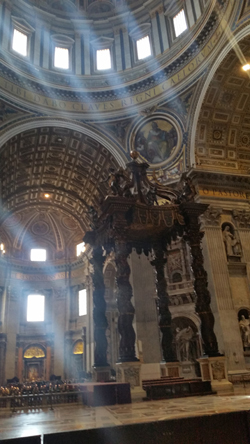 Our next appointment was quite special: the Scavi Tour, which covers the recently (in Roman time) unearthed tombs beneath the catacombs under St. Peter's Basilica. Our wonderful guide, a seminarian named Peter, told us how St. Peter's remains were found. Emperor Nero built a circus (used for races and other entertainment) around 40 A.D. in the area of the present St. Peter's. There was a terrible fire there in July of the year 64 that destroyed the circus. The Emperor Nero blamed Christians for the fire and this began a time of persecution. St. Peter was caught up in this and was crucified in October of that year, upside down near an Egyptian obelisk that stood just outside the wall of the present St. Peter's Basilica (the obelisk now stands in the middle of St. Peter's Square).
Our next appointment was quite special: the Scavi Tour, which covers the recently (in Roman time) unearthed tombs beneath the catacombs under St. Peter's Basilica. Our wonderful guide, a seminarian named Peter, told us how St. Peter's remains were found. Emperor Nero built a circus (used for races and other entertainment) around 40 A.D. in the area of the present St. Peter's. There was a terrible fire there in July of the year 64 that destroyed the circus. The Emperor Nero blamed Christians for the fire and this began a time of persecution. St. Peter was caught up in this and was crucified in October of that year, upside down near an Egyptian obelisk that stood just outside the wall of the present St. Peter's Basilica (the obelisk now stands in the middle of St. Peter's Square).
Because the Romans had great respect for the dead, even the Christian remains, including St. Peter's, were buried in the cemetery there. Later a pagan temple was built, but in the early 300s, Constantine (the first Christian emperor) built a church. The church later fell into disrepair and was rebuilt over the period from about 1530 to 1650.
All this time, St. Peter's remains were thought to be under the basilica, but for fear of disturbing the building above, they remained buried. Finally, in 1941, a careful excavation began and bones that are thought to be St. Peter's were found. At the end of the tour, we saw the bones in that spot, now enclosed in a glass case.
The final event of the day was a talk by Cardinal Peter Turkson of Ghana on "The Deacon: Called to be a Dispenser of Charity in the Christian Community." Cardinal Turkson is the head of the Pontifical Council for Justice and Peace.
Some highlights from his talk: 1) As Pope Francis said, mercy is love in action, 2) we must evangelize the institutions of society, 3) Moses brought God's Word to the people and was trustworthy, just like deacons are called to do and to be, and 4) deacons' wives play a very important part of their husbands' ministry.
EXTRA: Read Deacon Jim Bozik's daily reflection for Saturday: https://penzu.com/public/065998c2
Sunday, May 29
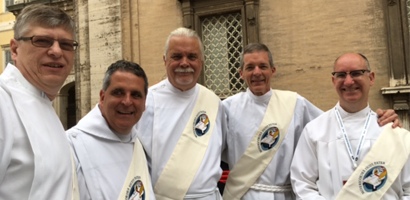 Today is the high point of our trip – Mass with Pope Francis.
Today is the high point of our trip – Mass with Pope Francis.
The deacons were told to be at the security station by 7:45 for the 10:30 Mass. In recent years, they have installed airport style X-ray machines and metal detectors at the entrance to the Basilica and other sites. It took about an hour to get through security and we spent the time talking to deacons from England, Raleigh, and France. It's interesting that all of us face the same types of issues regardless of location. After getting screened, we proceeded inside the Vatican gates, past the Swiss Guards, into the Paul VI Audience Hall for vesting. We were given white stoles with the insignia of the Jubilee of Mercy: an image of Jesus with a boy on His shoulders with the words "Miserdicoria como il Padre" meaning "Merciful Like the Father."
We processed into St. Peter's Square to our seats on either side of the altar, about three rows from the front. We never got an exact count of the number of deacons attending the jubilee, but it was probably about 2,000. There was a rush of applications during the last two weeks, so the organizers had to do some scrambling to handle everyone. The Italian secret service agents were ever present, showing how the world always breaks into our faith and worship.
The crowd was very lively, anticipating the coming of the Holy Father. Wisely, the announcer began reciting the rosary at about 10 a.m. to quiet the crowd. Then, the entrance procession began and Pope Francis entered. He was seated behind the altar, just in front of the Basilica and we had a very good view of him.
On Saturday evening, some deacons were called to serve the Mass – what an honor! Vested in albs, we were hot at times, but during the Mass there was a light shower that cooled things off. It was a joy to be in the presence of so many deacons from around the world – old and young (in deacon terms), of different nationalities and races, all called to serve the Lord in a special way. The readings were in Italian, Spanish, English, German, French, and Vietnamese.
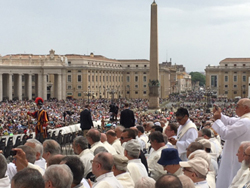
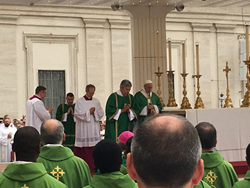 In His homily, the Holy Father told us deacons to be generous with our lives and our time, giving up the idea of being master of his day.
In His homily, the Holy Father told us deacons to be generous with our lives and our time, giving up the idea of being master of his day.
"One who serves cannot hoard his free time, because he knows that his time is not his own, but a gift from God which is then offered back to Him. Only in this way will it bear fruit."
We should ignore timetables and the church doors should always be open to help people, even if it entails setting aside what we like to do. We must be "good and faithful servants, not slaves to our own agendas, ever available for God's constant surprise." If we do this, our ministry will be "evangelically fruitful."
At the Table of the Eucharist we find the presence of Jesus so we can give ourselves to others. We must encounter Our Lord in the poor. (Our Italian is not good, this is from a translation). A prototypical message from Francis: simple, to the point, challenging and stressing service to the needy.
The Mass was fairly simple, as was Pope Francis' proclamation of the prayers. After the final blessing, he stood behind the altar, removed his vestments and donned the typical papal garb. Francis had a humble and solemn demeanor during the Mass, but as he met with the faithful afterward, his smile broadened and one could see he truly enjoys being among his flock. He greeted those who had participated in the Deacons' Jubilee and then began a tour of the clergy seated on either side: first priests and bishops, then deacons.
As he walked along our side, Deacons Mark and Jim were very close and Deacon Mark was able to kiss the Holy Father's ring. Next, the pope walked to the foot of the stairs, climbed aboard the popemobile and made a tour through the crowd, which filled the piazza and spilled into the Via de Conziliazone, the street extending into Rome from the Vatican.
Then, we just stood there, in awe of what we had experienced. Most deacons never have the opportunity to be vested for Mass with the Holy Father and encounter him so closely. We are truly blessed.
Our last event of the trip was to see the inside of St. John Lateran, which was closed for the Papal Mass when we sent there on Thursday. By this time we were getting better at navigating the subway and we made it there quickly. St. John Lateran was built by order of Constantine and it is the oldest church in Rome. It was built to honor St. John the Baptist and St. John the Evangelist. There are massive statues of the 12 Apostles lining the main nave. The structure over the main altar is quite impressive, with statues of Sts. Peter and Paul.
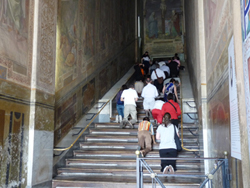 Upon leaving the basilica, we decided to visit a building across the street that contains the Scala Sancta (Holy Stairs). The small worship space inside is called the Sancta Sanctorum (Holy of Holies) and was the personal chapel of the early popes, known as the Chapel of St. Lawrence. The building contains 28 steps that were said to come from the praetorium of Pontius Pilate and were walked on by Jesus. They were brought to Rome by St. Helena, Constantine's mother. They are covered with wood and the tradition is to ascend them on one's knees as a penitential act. The photo shows Deacons Jim and John doing so, with great difficulty.
Upon leaving the basilica, we decided to visit a building across the street that contains the Scala Sancta (Holy Stairs). The small worship space inside is called the Sancta Sanctorum (Holy of Holies) and was the personal chapel of the early popes, known as the Chapel of St. Lawrence. The building contains 28 steps that were said to come from the praetorium of Pontius Pilate and were walked on by Jesus. They were brought to Rome by St. Helena, Constantine's mother. They are covered with wood and the tradition is to ascend them on one's knees as a penitential act. The photo shows Deacons Jim and John doing so, with great difficulty.
Next, I will share some reflections from our trip.
EXTRA: Read Deacon Jim Bozik's daily reflection for Sunday: https://penzu.com/public/162137df
Monday, May 30
How to begin to summarize our pilgrimage for the Jubilee of Deacons? First, the statistics:
· 9,600 miles flown from CLT to Rome and back
· Hundreds of thousands of steps
· 20 meals
· Many glasses of wine
· 11 churches visited:
Major Basilicas (4) – St. Peter's, St. John Lateran (Rome Cathedral), St. Paul Outside the Walls, St. Mary Major
Basilicas (3) – Santa Maria Sopra Minerva (St. Mary Above Minerva), San Andrea della Valle (St. Andrew della Valle), San Clemente (St. Clement)
Churches (4) - Santo Spirito in Sassia (Church of the Holy Spirit in the Saxon district), North American College Chapel, Gesu (Jesus) Church, Scala Santa (Sacred Steps)
· Favorite tours: Scavi tour, St. Paul Outside the Walls
· Many, many friends made
We began the trip May 22 with great anticipation, but like life in general, not realizing exactly what lay in store for us. This was not just another vacation, but a pilgrimage to a holy place for a once-in-a-lifetime event.
Throughout the history of the Church, people have made pilgrimages to sacred places: the Holy Land, Rome, Assisi, Santiago de Compostela, Lourdes, Fatima. They go for devotion to a particular saint, for healing, for inspiration, for repentance, for hope, or maybe just for curiosity. For whatever reason, they are transformed in some way and will never be the same. So it was with us.
As the Church reminds us, we Christians are a pilgrim people, journeying on the way to salvation. During our pilgrimage, we were delighted and disappointed, but it was all good. God surprises and challenges us so we don't forget who's in charge.
A trip like this in the presence of so many good and faithful people re-energizes one's faith and gives us the determination to press on regardless of our problems and sinfulness and that of the world. The Resurrection of Our Lord and His saving power makes us Christians a people of hope, even in life's darkest hours.
We urge you to make your own pilgrimage to an overseas site or wherever you can – even if it's just a short drive or walk to a local sacred place – so that you can be transformed and grow in God's grace.
May God bless you and your families abundantly.
RELATED NEWS:
Deacons gather in Rome, share reflections on ministry, challenges: Thousands of deacons and their families, braving the increasingly hot and humid Rome weather, attended the final Mass of the three-day Year of Mercy celebration dedicated to the diaconal ministry.
Ignore the church schedule and serve the people, pope tells deacons: Deacons are called to be servants who set aside their own self-serving plans and are generous with their lives, Pope Francis said.


